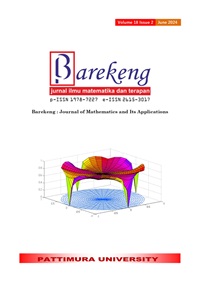APPLICATION OF ARIMA MODEL FOR FORECASTING NATIONAL ECONOMIC GROWTH: A FOCUS ON GROSS DOMESTIC PRODUCT DATA
Abstract
This study aims to apply the Autoregressive Integrated Moving Average (ARIMA) model to predict national economic growth, specifically focusing on Gross Domestic Product (GDP) data. GDP data were collected from 2012 to 2023, categorized into training data for the period 2012-2022 and testing data for the year 2023. Utilizing the training data, the research findings indicate that the ARIMA (0,1,0) (0,0,1) model emerges as the most effective in forecasting Indonesia's GDP on a quarterly basis, considering current prices. Subsequently, the model was tested on the 2023 dataset, and it demonstrated accurate predictions aligned with patterns and trends identified during the training phase. The outcomes of this research contribute significantly to the field of economic forecasting in Indonesia, particularly in understanding and predicting the quarterly developments of GDP. The proposed ARIMA model can serve as an effective tool for decision-makers and economic analysts to strategically plan for future economic dynamics on a quarterly basis.
Downloads
References
Cindy Mutia Annur, “List of Population Numbers in G20 Countries, What Rank is Indonesia?", Katadata, 24 October 2023,”, [Online]. Available: https://databoks.katadata.co.id/datapublish/2023/10/24/daftar-jumlah-penduduk-di-negara-g20-indonesia-peringkat-berapa#:~:text=Jumlah%20ini%20menempatkan%20Indonesia%20di,mencapai%201%2C43%20miliar%20jiwa [Accessed: 30 October 2023].
P. Rahardja and M. Manurung, Macroeconomic Theory, Fourth edition. Depok, Jawa Barat: Publishing Institution, Faculty of Economics, University of Indonesia, 2008.
W. Easterly and S. Rebelo+, “Fiscal policy and economic growth an empirical investigation*,” Journal of Monetary Economics, page 417-458,1993.
Central Statistics Agency, "Quarterly Gross Domestic Product of Indonesia Quarterly Gross Domestic Product of Indonesia," DKI Jakarta: Central BPS, 2023.
B. E. Hansen, “Time series econometrics for the 21st century,” Journal of Economic Education, vol. 48, no. 3, pp. 137–145, Jul. 2017, doi: 10.1080/00220485.2017.1320610.
A. Asrirawan, S. U. Permata, and M. I. Fauzan, “Univariate Time Series Modeling Approach for Quarterly Prediction of Indonesia's Economic Growth Post COVID-19 Vaccination,” Jambura Journal of Mathematics, vol. 4, no. 1, pp. 86–103, Jan. 2022, doi: 10.34312/jjom.v4i1.11717.
R. A. G. Hyndman, Forecasting Principles and Practice. 2018
A. Ghazo, “Applying the ARIMA Model to the Process of Forecasting GDP and CPI in the Jordanian Economy,” International Journal of Financial Research, vol. 12, no. 3, p. 70, Jan. 2021, doi: 10.5430/ijfr.v12n3p70.
F. X. Diebold, “Time-Series Econometrics a Concise Course,” 2019.
Central Statistics Agency, “Quarterly GDP at Current Prices According to Expenditures (Billions of Rupiah) 2010-2023,” DKI Jakarta: Central BPS, 2023.
Puka. A.O. B, “Arimax Model for Forecasting Inflow and Outflow of Currency in Bank Indonesia, East Nusa Tenggara Province.” Researchgate, 2021. [Online]. Available: https://www.researchgate.net/publication/355545076 .
Neusser. K., Time Series Econometrics. Switzerland: Springer, 2016.
Bowerman and O’Connell, Time Series and Forecasting: An Applied Approach , 3rd ed. Boston: Duxburry Press, 1993.
D. Wulan Sari, R. Goejantoro, and S. Wahyuningsih, “Parameter Estimation of an ARIMA Model for River Flow Forecasting Using Least Square and Goal Programming,” Jurnal EKSPONENSIAL, vol. 7, no. 2, 2016.
W. Anggraeni, S. Si, and M. Kom, “Forecasting of Influenza and Dengue Fever Cases in Surabaya with Google Trends and Climate Data using variation of Autoregressive Integrated Moving Average (ARIMA) Method”, Department of Information System: Faculty of Information Technology, Sepuluh Nopember Institute of Technology, Surabaya, 2016.
J. K. Afriyie, S. Twumasi-Ankrah, K. B. Gyamfi, D. Arthur, and W. A. Pels, “Evaluating the performance of unit root tests in single time series processes,” Mathematics and Statistics, vol. 8, no. 6, pp. 656–664, 2020, doi: 10.13189/ms.2020.080605.
Y.Hanim, “Application of Time Series Regression and ARIMAX for Forecasting Inflow and Outflow Of Currency in East Java, DKI Jakarta, And National Levels”, Statistics Department: Faculty of Mathematics and Natural Sciences, Sepuluh Nopember Institute of Technology, Surabaya, 2015.
Copyright (c) 2024 Elisabeth Brielin Sinu, Maria A Kleden, Astri Atti

This work is licensed under a Creative Commons Attribution-ShareAlike 4.0 International License.
Authors who publish with this Journal agree to the following terms:
- Author retain copyright and grant the journal right of first publication with the work simultaneously licensed under a creative commons attribution license that allow others to share the work within an acknowledgement of the work’s authorship and initial publication of this journal.
- Authors are able to enter into separate, additional contractual arrangement for the non-exclusive distribution of the journal’s published version of the work (e.g. acknowledgement of its initial publication in this journal).
- Authors are permitted and encouraged to post their work online (e.g. in institutional repositories or on their websites) prior to and during the submission process, as it can lead to productive exchanges, as well as earlier and greater citation of published works.






1.gif)



